Physical Address
304 North Cardinal St.
Dorchester Center, MA 02124
The diagnostic approach to pediatric lung biopsy differs somewhat from that in the adult patient. Many of the usual questions that arise in adult pulmonary pathology are replaced by separate issues involving abnormal development, altered lung growth due to prematurity, genetic disease, and infections secondary to an immature immune system. Moreover, the spectrum of diseases observed in the pediatric lung biopsy differs from its adult counterpart, and it is important to approach these biopsies with knowledge of lung development and anatomy. In addition, because most pediatric lung diseases are non-neoplastic in nature, communication with the clinician, the radiologist, and the surgeon is essential because a tentative list of diagnostic considerations usually can be built on the basis of clinical, radiologic, and intraoperative findings. This chapter covers a spectrum of common and rare entities that the surgical pathologist may encounter when examining biopsied and resected specimens from pediatric patients. In keeping with the pattern-based approach theme of this book, Table 5.1 lists the pediatric lung diseases as they correspond to the 6 patterns of pulmonary pathology.
| Pattern | Diagnosis |
|---|---|
|
|
|
|
|
|
|
|
|
|
|
|
General processing of lung biopsy specimens is covered in Chapter 3 . Recommendations have been published for processing of pediatric biopsy specimens for diffuse lung disease. A point worthy of emphasis is that in both diffuse and localized disease of the pediatric lung, infection should always be considered, and a substantial portion (one-third to one-half) of the surgical lung biopsy specimen should be sent for cultures if the surgeon has not already sent culture samples directly from the operating room. Touch imprints of the biopsy cut surface can be made and rapidly stained with silver stains for fungi or acid-fast stains for mycobacteria, a technique that is particularly useful for processing of lung biopsy specimens from immunosuppressed or immunocompromised patients. A few small pieces should be retained in glutaraldehyde for electron microscopy, which may have utility in the diagnosis of genetic disorders of surfactant metabolism and viral infections. Additional tissue should be snap-frozen and retained for potential molecular diagnosis of genetic disorders or infectious processes. For patients with suspected autoimmune diseases or chronic hemorrhage syndromes, a piece of lung tissue should be frozen in cryomatrix for possible immunofluorescence study. The remaining lung tissue should be expanded with formalin using a tuberculin syringe or other fine needle by transpleural injection, fixed for approximately 10 minutes, and sectioned for histologic examination. Inflation of pediatric lung biopsy is essential to reproduce the in vivo lung architecture and enables microscopic assessment of alveolar growth and development. In addition to standard hematoxylin and eosin (H&E) stains, many cases of diffuse disease benefit from the addition of connective tissue stains, such as trichrome, Verhoeff-van Gieson, or Movat pentachrome stains, for further evaluation of vascular disease or small-airway scarring, both of which may be under recognized with use of routine stains. Additional staining for microorganisms, iron, glycogen, and alveolar proteinosis should be performed when indicated.
Gross examination is a critical component of the pathologic assessment of cystic malformations. In particular, the diagnosis of bronchial atresia and intralobar sequestration (ILS) requires attention to gross characteristics that cannot be replicated microscopically. Lesions submitted with a working diagnosis of “congenital cystic adenomatoid malformation” may yield a wide array of pathologic diagnoses, including bronchial atresia, ILS, large cyst congenital pulmonary airway malformation (CPAM), and congenital lobar overinflation (CLO).
Accurate classification of these lesions is facilitated by use of a standard approach to identification of specific anatomic features. The pleura should be examined for accessory pseudofissures, which often mark the contour of underlying maldeveloped lung, typically corresponding to a segmental distribution in bronchial atresia or ILS. ILS is often distinguishable by a segmental region of pulmonary congestion and hemorrhage. The pleural surface is examined for the presence or absence of ligated vessels correlating with entry of an aberrant systemic artery, typically at the medial basal aspect of a lower lobe lesion.
The hilum is examined for a bulging mucocele that may correspond with an atretic bronchial segment. The patent airways at the hilum are inflated with formalin by transbronchial injection, and the distribution of parenchymal expansion is observed, with uninflated segments potentially corresponding to a region of lung distal to a bronchial atresia or ILS. The lobe is sectioned in a parasagittal plane from lateral to medial, preserving the hilum for the last section. Areas of abnormally congested, hyperinflated, or cystic lung parenchyma are documented. A region of microcystic lung parenchyma can be traced with each plane of section toward the hilum until a larger mucus-filled cyst (mucocele) or other dilated airway is recognized, at which point retrograde probing of the airway may assist in documenting the blind-ending point of an atretic bronchus in either isolated bronchial atresia or ILS (bronchial atresia with systemic arterial supply). Microscopic sections should represent central and peripheral aspects of both normal lung and abnormal cystic regions, with interface sections providing a useful histologic contrast between normally developed alveoli and abnormally developed parenchyma. Hyperinflated lobes typical of CLO should prompt attention to the hilar bronchi for identification of stenotic lesions or bronchomalacia. Large unilocular or multilocular cysts need to be sampled extensively to distinguish CPAM from the cystic form of pleuropulmonary blastoma (PPB).
Many pediatric lung biopsies and resections are performed for localized abnormalities within the lungs, and these may be solid or cystic ( Box 5.1 ). A number of clues can be obtained from the history and findings on diagnostic imaging and intraoperative inspection, and these can be helpful in making the correct diagnosis, even before slides have been reviewed. The location of the mass, the presence of cystic or solid areas, the vascular and bronchial supply, and the onset of symptoms can all be useful in narrowing the scope of the differential diagnosis.
Mediastinal cysts
Bronchogenic cyst
Bronchopulmonary foregut malformation
Esophageal duplication cyst
Thymic cyst
Pericardial cyst
Bronchial atresia
Pulmonary sequestrations
Intralobar sequestration
Extralobar sequestration
Congenital pulmonary airway malformation
Acquired cysts
Abscess
Pneumatocele
Cystic bronchiectasis
Postinfarction cyst
Pulmonary interstitial emphysema, acute or persistent
Peripheral cysts of pulmonary maldevelopment (Down syndrome) or chronic lung disease
Neoplasia
Pleuropulmonary blastoma
Cystic teratoma
Bronchogenic cysts are developmental anomalies formed by abnormal budding of the tracheobronchial anlage of the primitive foregut in early development. , They are commonly found in the anterior mediastinum or along the tracheobronchial tree. Less often, they are found within the pulmonary parenchyma, within or below the diaphragm, or even within the pericardium. , Patients with bronchogenic cysts can present with infection or obstruction, although frequently these lesions are an incidental radiologic finding. The cyst is often unilocular and lined with ciliated columnar epithelium. Many bronchogenic cysts communicate with the tracheobronchial tree. On occasion, they show squamous metaplasia or chronic inflammation.
Considerations in the differential diagnosis for bronchogenic cyst include esophageal duplication cyst for lesions occurring in the mediastinum and CPAMs or bronchial atresia for lesions occurring within the substance of the lung. The bronchogenic cyst typically has cartilage plates and submucosal glands in the wall, similar to the normal microscopic anatomy of bronchi ( Fig. 5.1 ). These structures may be sparse but can help differentiate this lesion from the esophageal duplication cyst, which lacks these structures and has a double muscular layer in its wall. Both of these entities can be lined with ciliated mucosa. The bronchogenic cyst is unilocular and lacks connection with alveolar tissue, a feature that aids in its distinction from CPAM.
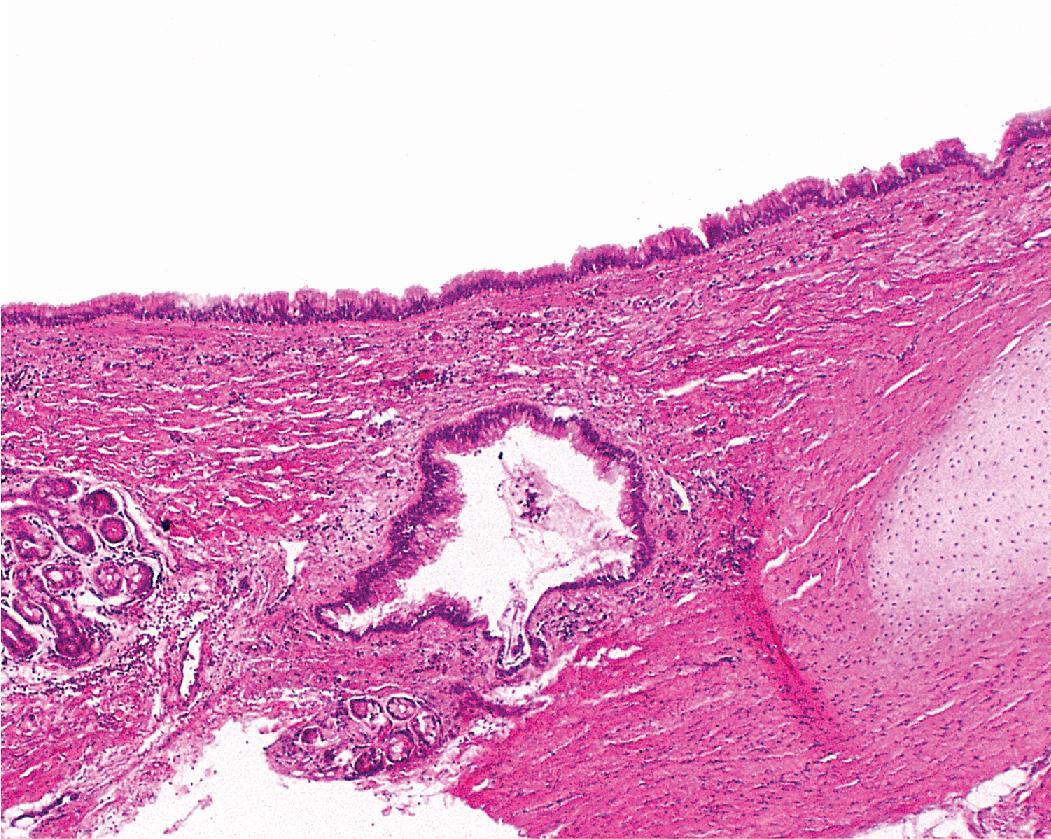
Bronchial atresia is one of the most common forms of congenital pulmonary malformation. Atresia of a segmental or subsegmental bronchus classically results in a central mucus-filled cyst (mucocele) at the point of atresia, dilated distal airways with mucous plugs, and hyperinflated microcystic distal parenchyma ( Fig. 5.2 ). Microscopically, the abnormally developed cystic parenchyma often has a pattern identical to that described in type 2 CPAM, consisting of increased numbers of abnormal bronchiolar structures surrounded by variably abundant alveolar spaces, which are typically distended and round or elongated in shape. , Other cases show more subtle maldevelopment and hyperinflation of airspaces. Abundant mucus and muciphages are typically noted within proximal airway lumens and adjacent air spaces. The combination of mucus stasis and alveolar maldevelopment in a segmental or multisegmental distribution should raise suspicion of intrauterine bronchial obstruction, most commonly due to bronchial atresia.
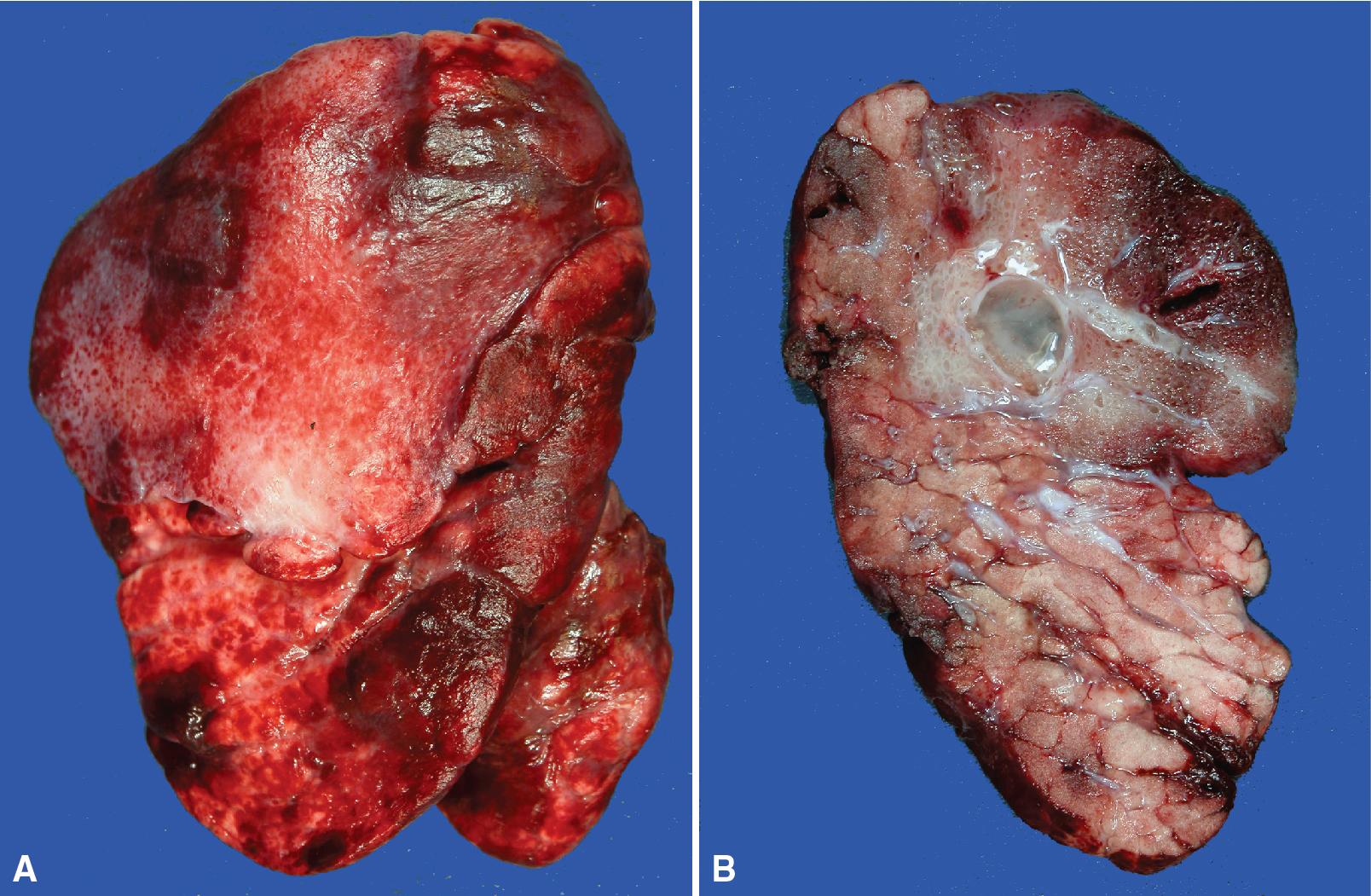
Bronchial atresia is often detected prenatally or in infancy as an asymptomatic cystic lesion. Because of interconnection with the normal parenchyma through alveolar pores of Kohn, the abnormal lung distal to a bronchial atresia may potentially become secondarily infected, and presentation in later childhood, adolescence, or adulthood typically is due to symptoms of recurrent pneumonia. The primary considerations in the differential diagnosis are CLO, which is characterized by normally developed (albeit markedly distended) air spaces, and ILS, which is distinguished by the additional finding of aberrant systemic arterial supply.
Pulmonary sequestration refers to the occurrence of lung tissue that does not communicate with the tracheobronchial tree and that typically has a systemic, rather than pulmonary, arterial supply. Such lung tissue is therefore “sequestered” from the usual pulmonary airway and vascular connections. These lesions are further subdivided into an extralobar type, which occurs outside the visceral pleura of the adjacent lung, and an intralobar type, which resides within the visceral pleural investment of a lung lobe. Although there is general agreement that extralobar sequestrations (ELSs) represent congenital malformations, the origin of ILSs has been more controversial in the past. Diagnosis in adults has led to the theory that they are postinflammatory lesions with acquired loss of bronchial connection and development of collateral systemic circulation from hypertrophied pulmonary ligament arteries. However, ILSs diagnosed prenatally or in association with congenital malformations support the concept that the pathogenic mechanisms for ELS and ILS are indeed similar, and that adult lesions represent occult malformation detected later in life. Specific features of ELS and ILS, summarized in Table 5.2 , are discussed next.
| Clinical/Historical Feature | Extralobar Sequestration | Intralobar Sequestration |
|---|---|---|
| Location | Outside pleura of lung (“accessory lobe”)Commonly, left lung base |
|
| Gross | Pyramidal structure | Congested, hemorrhagic segment(s) of lobe |
| Age at diagnosis | 60% <6 months | 50% >20 years |
| Arterial supply | Systemic | Systemic |
| Origin | Congenital anomaly | Congenital anomaly |
| Histologic appearance | CPAM type 2 pattern—hyperinflated air spaces |
|
ELSs are thought to arise as a result of abnormal budding from the tracheobronchial anlage. Lying outside the normal lung, these structures appear as “accessory lobes,” completely surrounded by their own visceral pleura. ELSs are usually found in the lower thoracic cavity but may be found above, within, or below the diaphragm. On gross inspection, they appear as irregularly ovoid or pyramidal portions of lung tissue surrounded by pleura and with a vascular pole at one edge ( Fig. 5.3 A). The radiographic or intraoperative finding of a systemic arterial supply confirms the diagnosis of ELS. The systemic artery can arise from a source above or below the diaphragm. , The microscopic appearance may vary, but the histologic pattern is typically that of type 2 CPAM and less often resembles that of normal lung (see Fig. 5.3 B,C). , , , Striated muscle is occasionally present within the interstitium of the lesion; this feature is called rhabdomyomatous dysplasia .
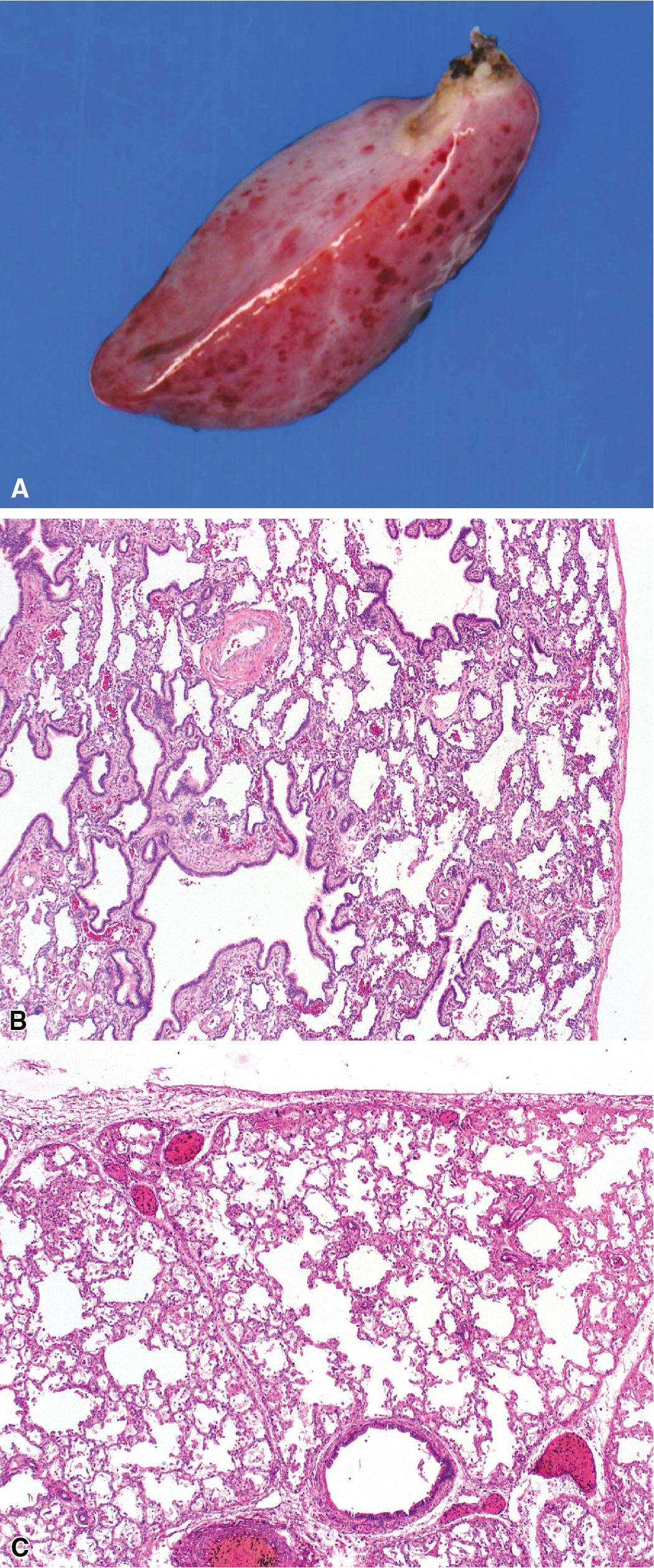
ILSs lie within the parenchyma of a lung lobe. Most ILSs occur in the medial area of a lower lobe, and the abnormal systemic elastic artery can usually be identified in the region of the inferior pulmonary ligament ( Fig. 5.4 A). Radiologic studies can be extremely helpful in supporting the diagnosis. , Various modalities, including computed tomography (CT) and magnetic resonance imaging, will show a solid or cystic mass that lacks normal bronchovascular patterns. A systemic arterial supply may be confirmed radiologically or at the time of surgery. The gross and microscopic findings are markedly influenced by age at resection and presence or absence of any accrued chronic inflammatory insults (usually secondary infections) within the sequestered lung tissue. In infants with asymptomatic lesions, the lobe contains a segmental region of congestion and hemorrhage due to the high flow of the systemic circulation, accompanied by microcystic parenchyma (see Fig. 5.4 B). The maldeveloped parenchyma shows mucus stasis, identical to that in segmental bronchial atresia ( Fig. 5.5 A). In older children and adults with recurrent pneumonia, the histologic findings are similar in appearance to those in localized bronchiectasis with recurrent infection. Other features include marked acute and chronic inflammation with fibrosis and cyst formation (see Fig. 5.5 B). On gross examination, the abnormal systemic arterial supply can be identified at the medial inferior angle of an intact lower lobe specimen but may be difficult to identify in a morcellated thoracoscopic lobectomy specimen. Correlation with chest CT and intraoperative findings is necessary in such cases.
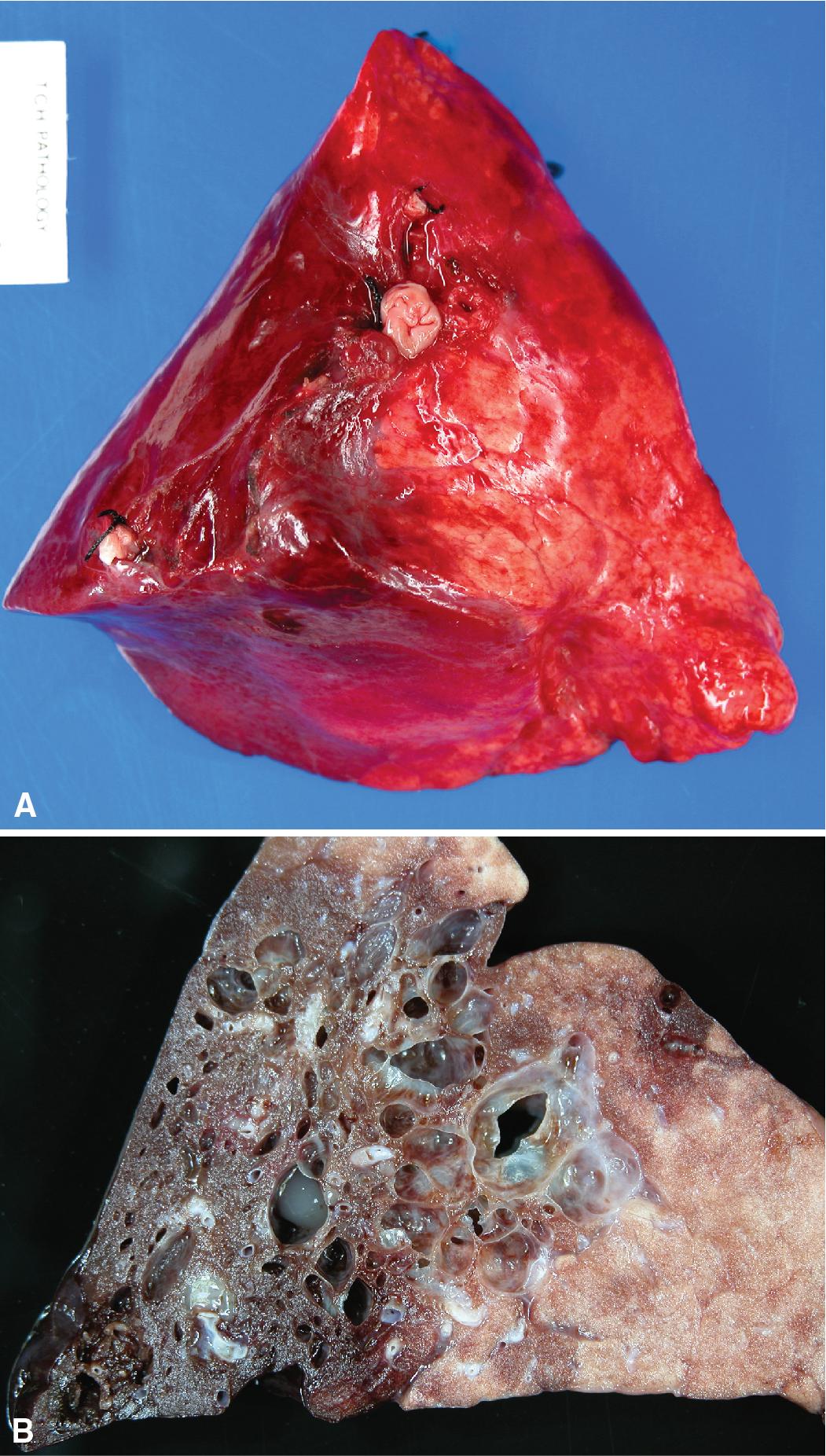
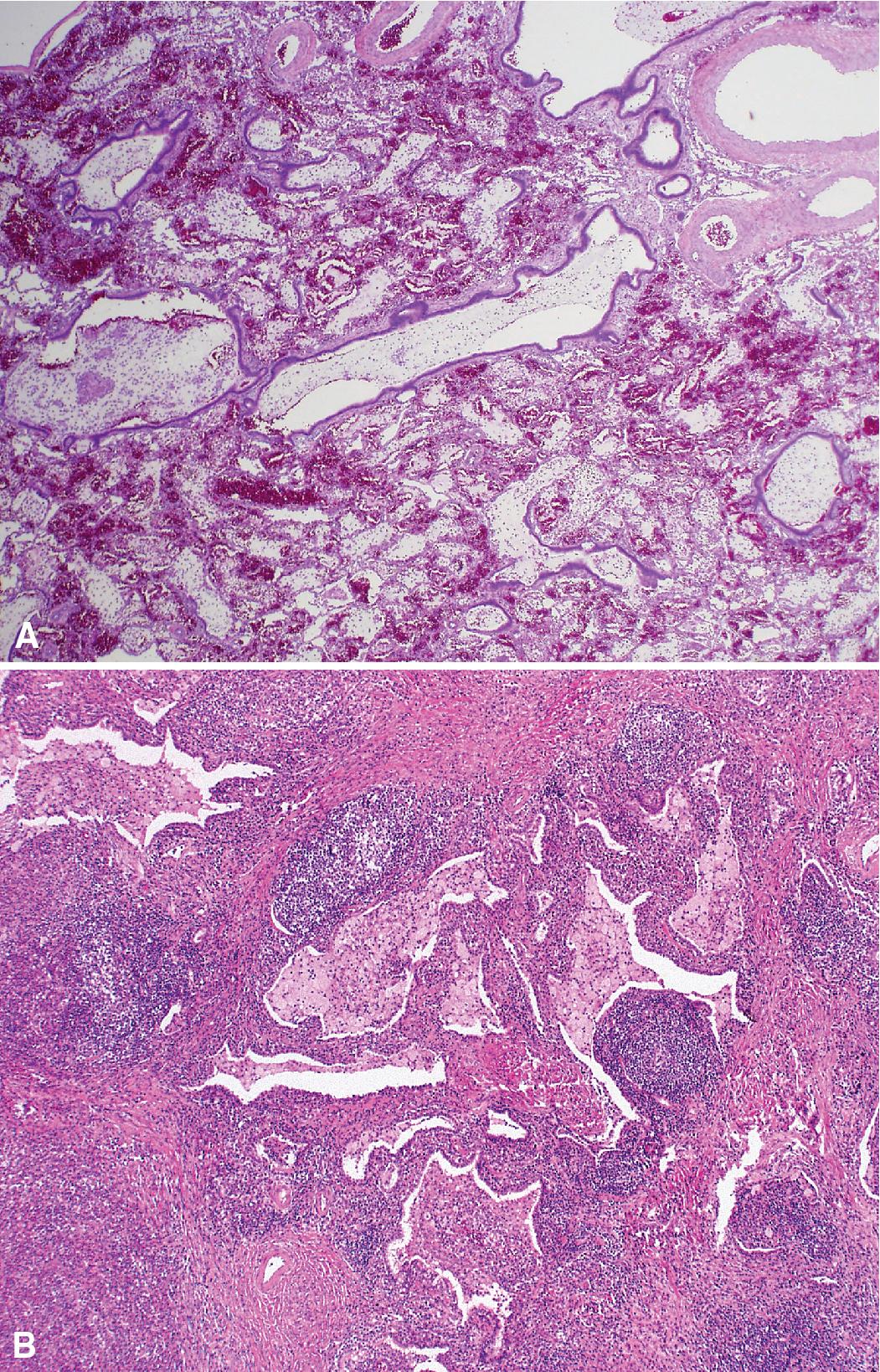
CPAMs, also called congenital cystic adenomatoid malformations (CCAMs), are masses of maldeveloped lung tissue that are classified according to their gross and microscopic appearance. , These lesions are identified most commonly in stillborn infants or in newborns with respiratory distress, but they can be discovered in older children, adolescents and rarely in adults. Stocker and colleagues initially proposed a classification scheme for CCAM that divided these malformations into three subtypes. This scheme was later expanded to five subtypes (types 0–4), with a subsequent change in terminology from CCAM to CPAM, acknowledging that not all of these malformations are cystic and not all are adenomatoid. Historically, the overriding principle of this classification is that the dominant morphologic constituent of each type of CPAM reflects the morphology of the normal tracheobronchial tree from proximal to distal—that is, from malformed bronchi, to bronchioles, to distal lung (alveolar) tissue. This construct was derived from morphologic correlations, rather than critical examination of pathogenesis of each cyst type. CPAM classification has been integrated subsequently into a broader classification system for congenital lung malformations. Also, CPAM classification may be difficult in immature or fetal lungs, and an alternate classification has been proposed for fetal lung resections. ,
Type 0 CPAM, also called acinar dysplasia , is a rare lesion composed of cartilaginous airways and loose mesenchyme (see later discussion). Types 1 to 3 have a common general overall appearance of cystic spaces (distorted airways) with intervening structures more or less resembling alveoli ( Figs. 5.6–5.8 ). Type 1 CPAM shows larger cysts, having some bronchial differentiation in that they contain ciliated epithelial lining or mucinous-type epithelium or have cartilage in their walls. Type 2 CPAM shows smaller cystic spaces that resemble ectatic irregular bronchioles, evenly separated from each other by alveolar structures, and represent a histologic pattern that implies intrauterine bronchial obstruction, typically from bronchial atresia or pulmonary sequestration. Type 3 CPAM is a rare solid lesion typically encompassing an entire lobe or lung and resembles pulmonary hyperplasia or immature lung in the early canalicular stage of development, in some cases due to documented bronchial atresia or stenosis at the level of a lobar bronchus. Type 4 CPAM has been described as a peripheral large cyst with thin walls and flattened alveolar-type epithelial lining. It is now widely accepted that the lesions previously called type 4 CPAM are actually neoplasms, rather than malformations, and should lead to diagnosis of type 1 or type1R (regressed) PPB . Large cyst CPAMs should be extensively sampled to exclude the presence of small foci of malignant primitive spindled cells beneath the alveolar epithelium (“cambium layer”) or immature chondroid foci, diagnostic of cystic (type 1) PPB. Immunohistochemical staining for myogenin, desmin, and MyoD1 may be helpful in differentiating the cells of PPB from reactive fibroblastic proliferation or cellular mesenchyme in CPAM. Cystic PPBs have potential for recurrence as high-grade tumors, particularly if incompletely resected.
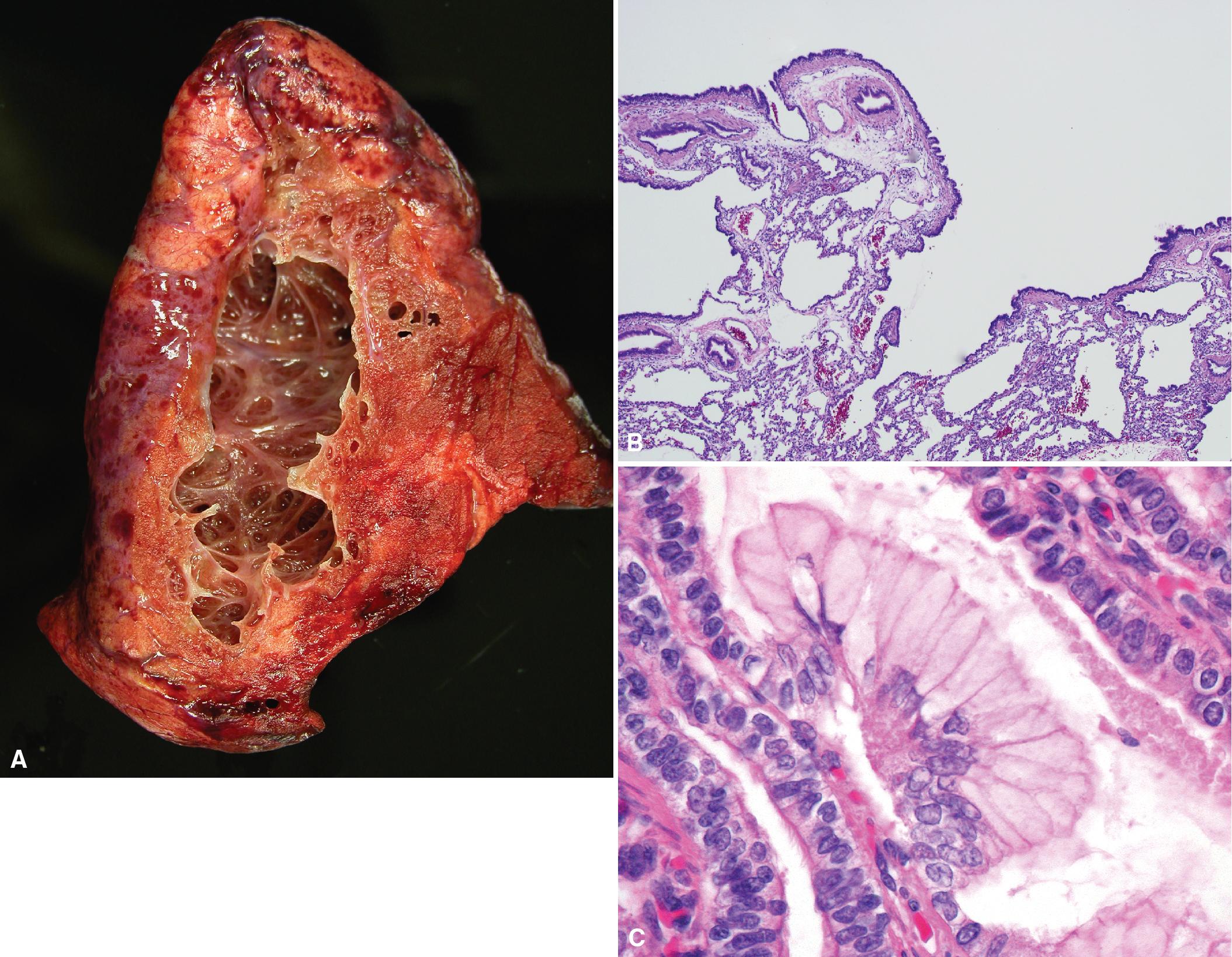
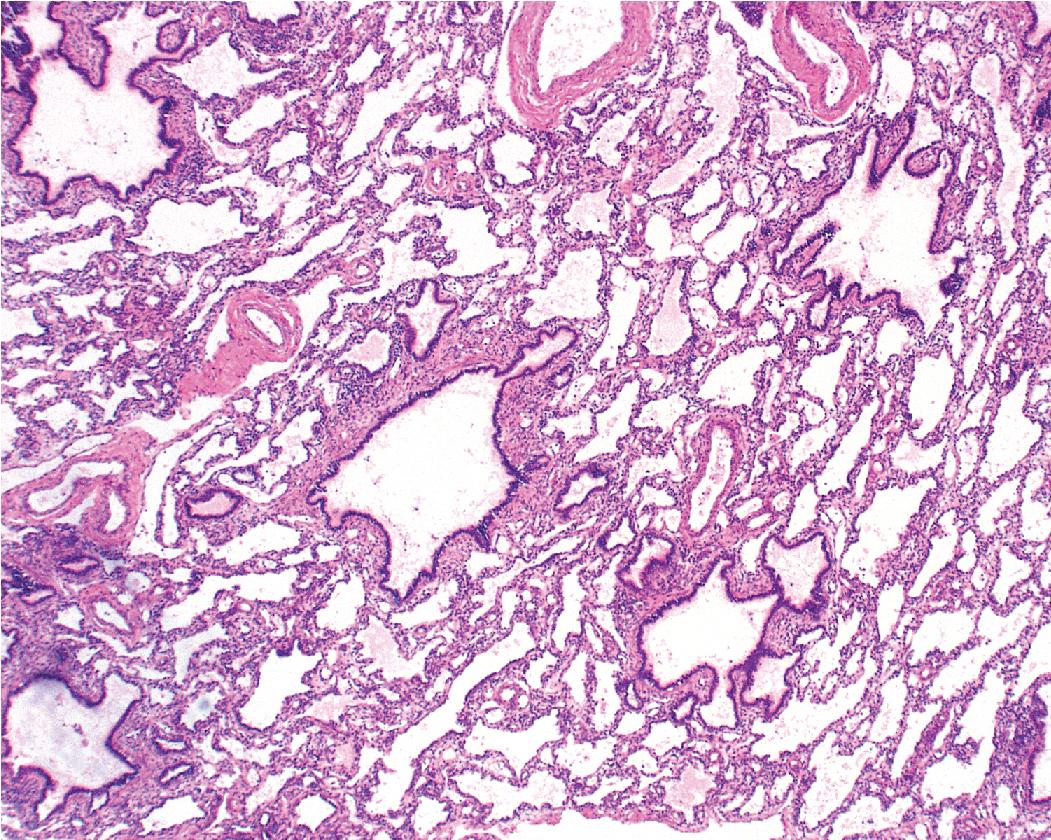
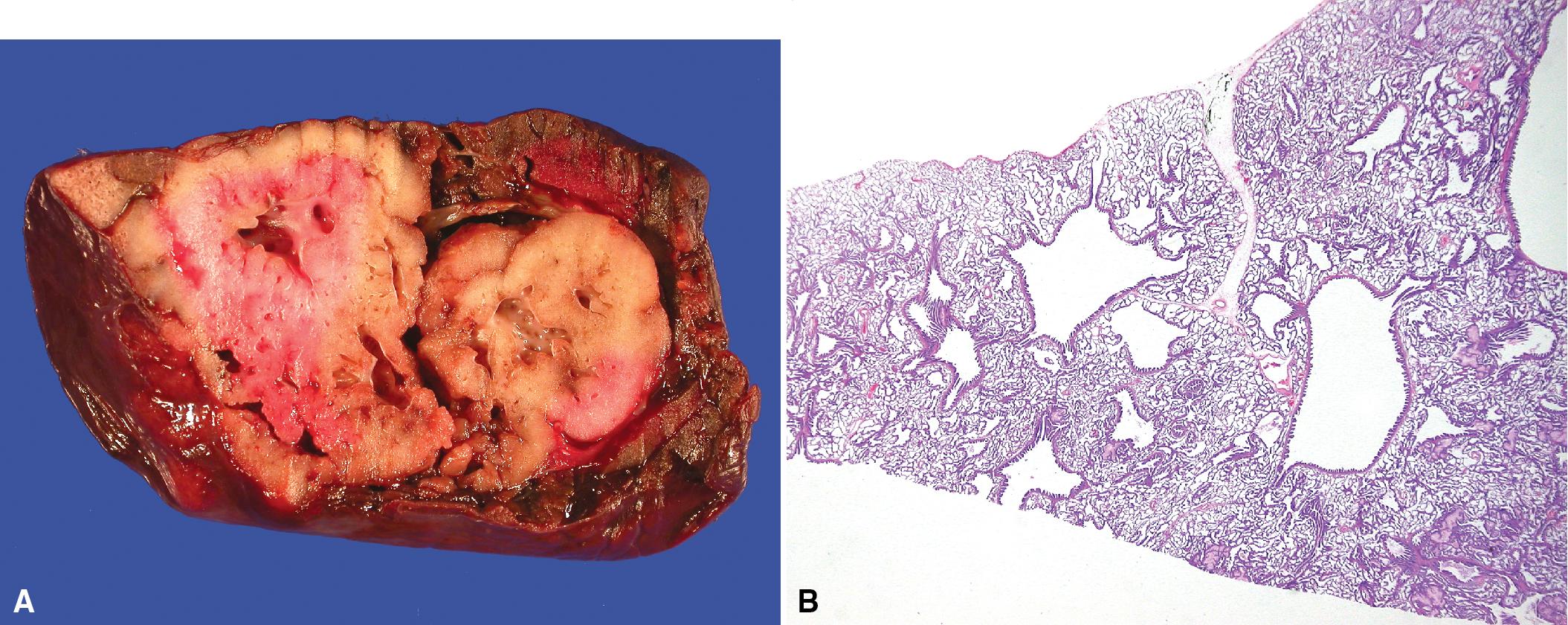
Although the prognosis in most cases is favorable following resection, there are rare, reported cases of patients developing carcinomas in association with CPAM. Many of these lesions are mucinous adenocarcinomas, which has led to the proposal that the mucigenic epithelium in type 1 CPAM is preneoplastic (see Fig. 5.6 C). Multifocal bilateral mucinous adenocarcinomas after incomplete resection of CPAM have been described in patients as young as 11 years of age. In light of these rare cases, the presence of mucinous epithelium in CPAM and completeness of resection should be documented for follow-up purposes.
Pulmonary interstitial emphysema (PIE) results from dissection of air into the interstitial connective tissue of the lung. Rupture of alveoli or disruption of airway walls is often responsible for this phenomenon. , Air accumulates in the interstitium along bronchovascular bundles and interlobular septa, creating cystic spaces that may at first resemble tissue architecturally torn during sectioning ( Fig. 5.9 A and B). The usual clinical scenario is that of a premature infant with neonatal respiratory distress syndrome (RDS) and stiff lungs resistant to mechanical ventilation, which leads to barotrauma and airleak. Pneumothorax is a common complication. Acute PIE usually resorbs over time, but the chronic form persists as cystic lesions lined by fibrous tissue or multinucleate giant cells (see Fig. 5.9 C). Grossly, the process can involve both lungs diffusely or may be localized to one or two lobes. Multiple small cysts can be seen to extend along interlobular septa.
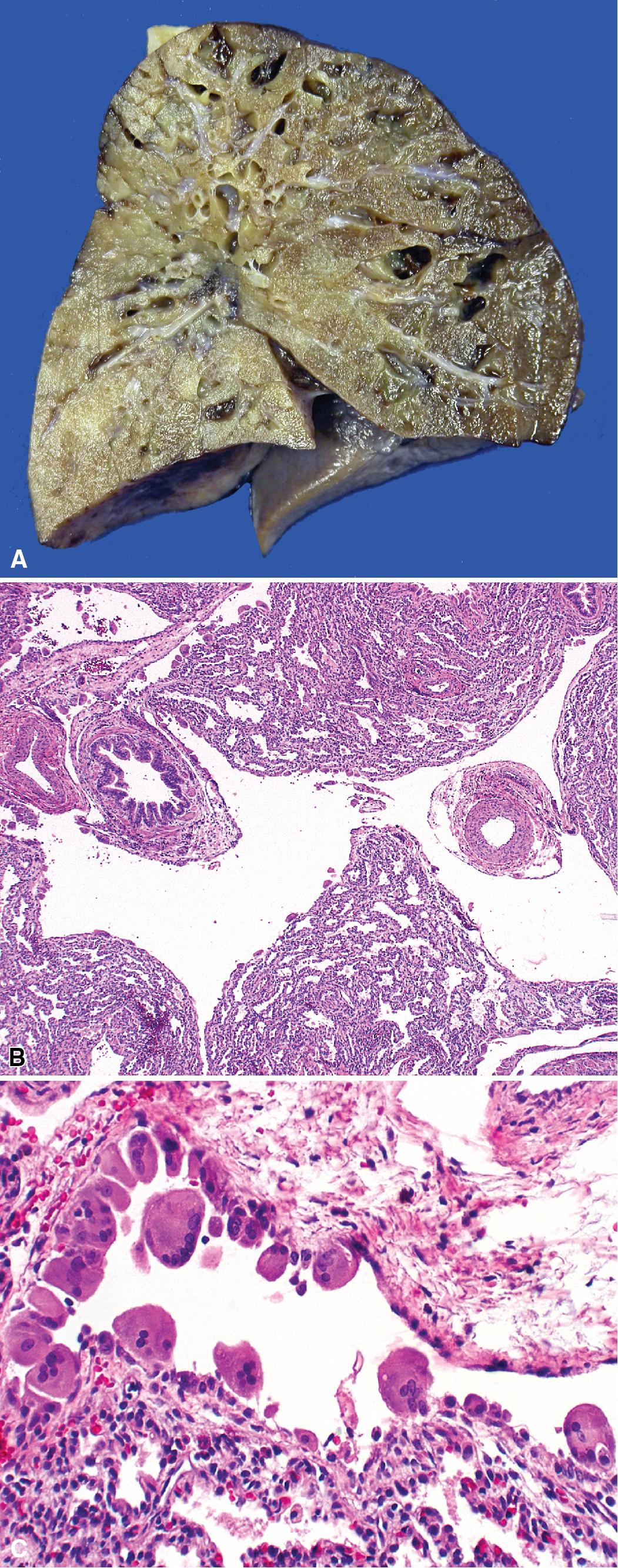
Hypoplastic lungs, and those damaged in the neonatal period, are susceptible to persistent alterations in alveolar growth. This maldevelopment frequently appears as alveolar enlargement or cysts, particularly in the subpleural areas and peripheral lobules. Microscopic examination reveals irregular air space enlargement with fibrovascular walls lined by alveolar cells ( Fig. 5.10 ). Peripheral cysts have been described in the lungs of some patients with Down syndrome, and are typically associated with inflammatory debris and cholesterol (endogenous lipoid pneumonia).
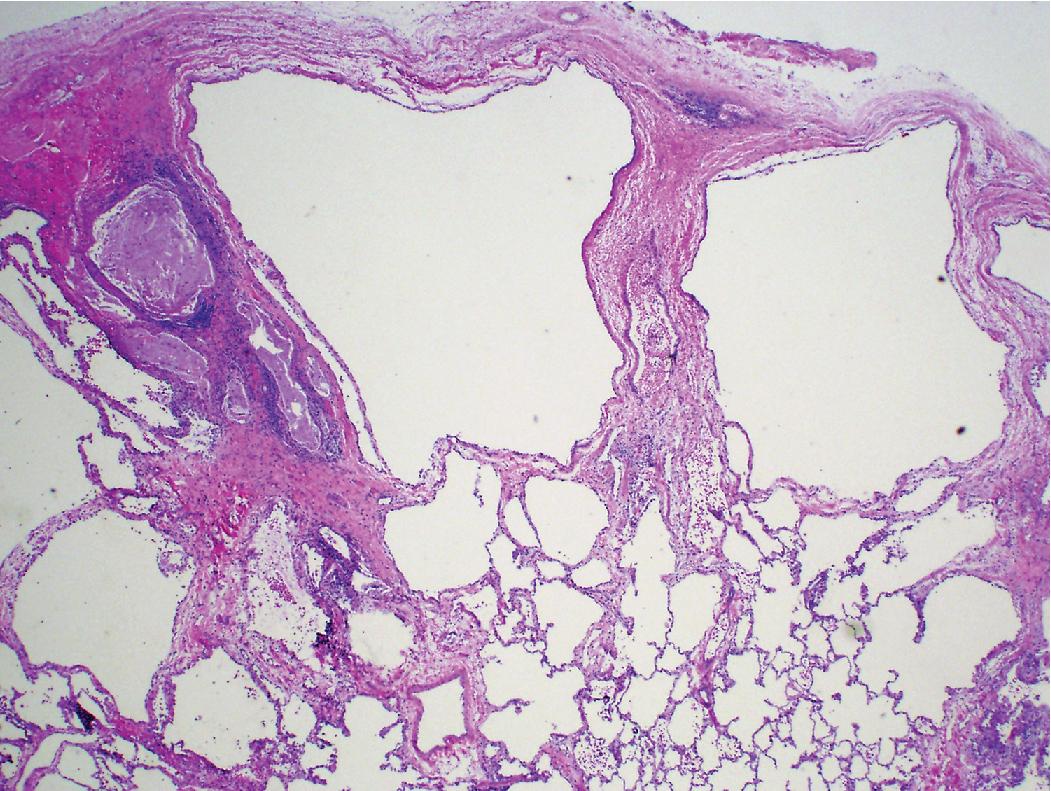
Several conditions may lead to the radiologic appearance of hyperlucency ( Box 5.2 ). Clinical history and knowledge of the indication for resection are helpful because the pathologic findings can be extremely subtle histologically. The clinical presentation may include shortness of breath, tachypnea, wheezing, or cough, typically in infants. The chest radiograph shows marked lobar enlargement with displacement of the mediastinum. The two most commonly occurring histologic patterns are CLO (so-called congenital lobar emphysema) (in 70% of the cases) and polyalveolar lobe (30%).
Congenital lobar overinflation
Idiopathic
Bronchial stenosis
Bronchial mucosal folds/webs
Extrinsic airway compression by mass or abnormal vasculature
Lobular hyperinflation due to small airway disease
Obliterative bronchiolitis (postinfectious, bronchopulmonary dysplasia)
Meconium aspiration
Mucous plugging
Polyalveolar lobe
CLO, or congenital lobar emphysema, occurs when there is overdistention of the normal alveolar parenchyma ( Fig. 5.11 ). , , The etiology is variable, but the underlying cause is frequently a partial or intermittent high-grade obstruction of the bronchus supplying the affected lobe. Bronchomalacia may result in collapse of the lobar bronchus with expiration, resulting in progressive air-trapping in the affected lobe. The obstruction can occur as a result of other intrinsic factors such as bronchial stenosis, abnormal “kinked” bronchial anatomy, mucosal webs, or mucous plugging. Alternatively, CLO can be extrinsic as a result of various vascular or neoplastic etiologies. Approximately one-half of the cases are idiopathic. The upper lobe is involved in nearly all cases. Lower lobe involvement is highly unusual except in acquired cases in patients with previous hyaline membrane disease or bronchopulmonary dysplasia (BPD). Some cases may arise secondary to trauma from tracheal suctioning during respiratory support.
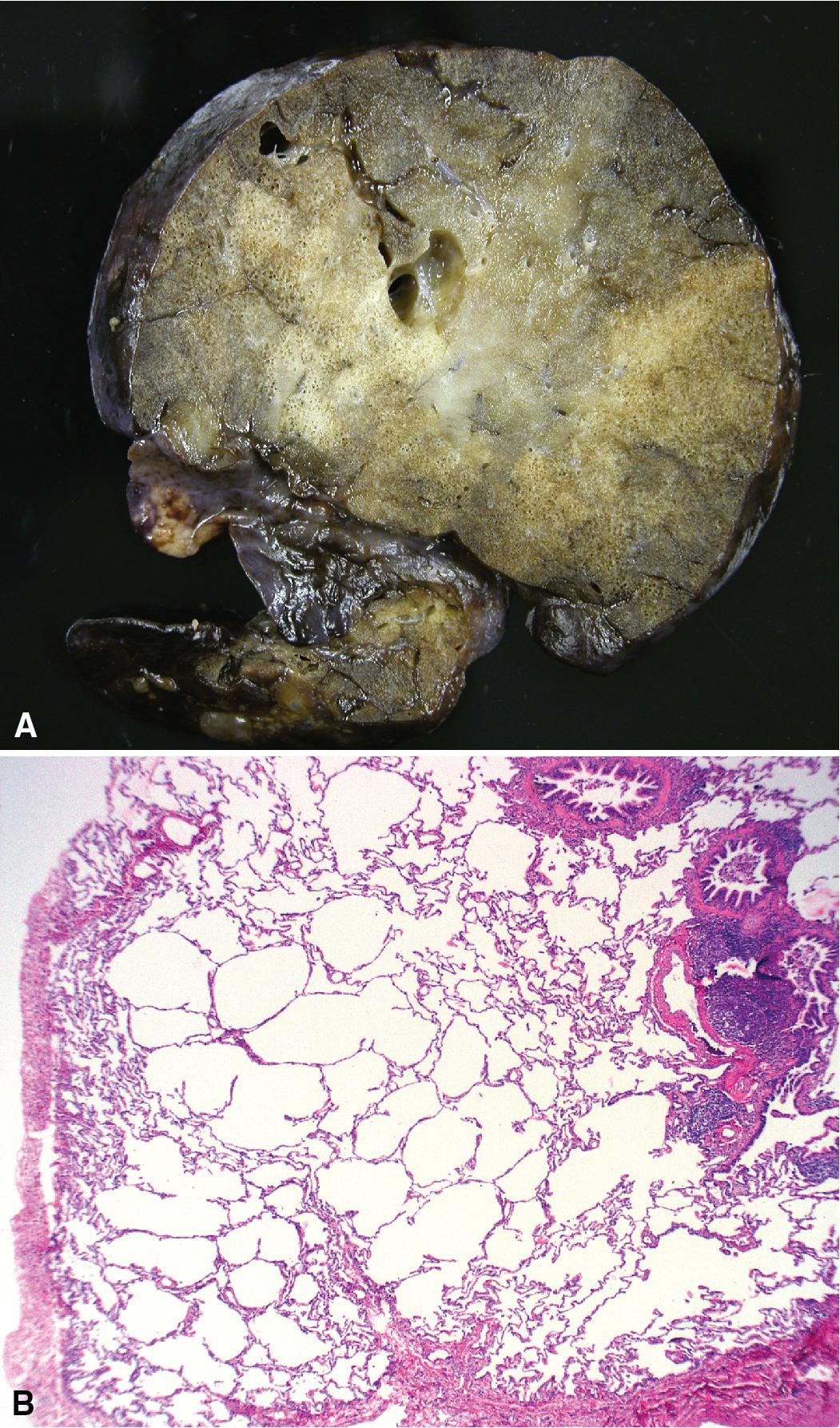
On gross examination, CLO is characterized by a markedly enlarged lobe, which generally retains its basic shape. Alveoli, alveolar ducts, and respiratory bronchioles are typically dilated on histologic examination. Unlike bronchial atresia and CPAM, CLO shows otherwise normal alveolar development, with appropriate numbers of bronchiolar structures and appropriate alveolar septation. The source of obstruction is identified only occasionally by gross and microscopic examination. ( Fig. 5.12 ). Evidence of bronchomalacia may be documented by bronchoscopy or operative reports.
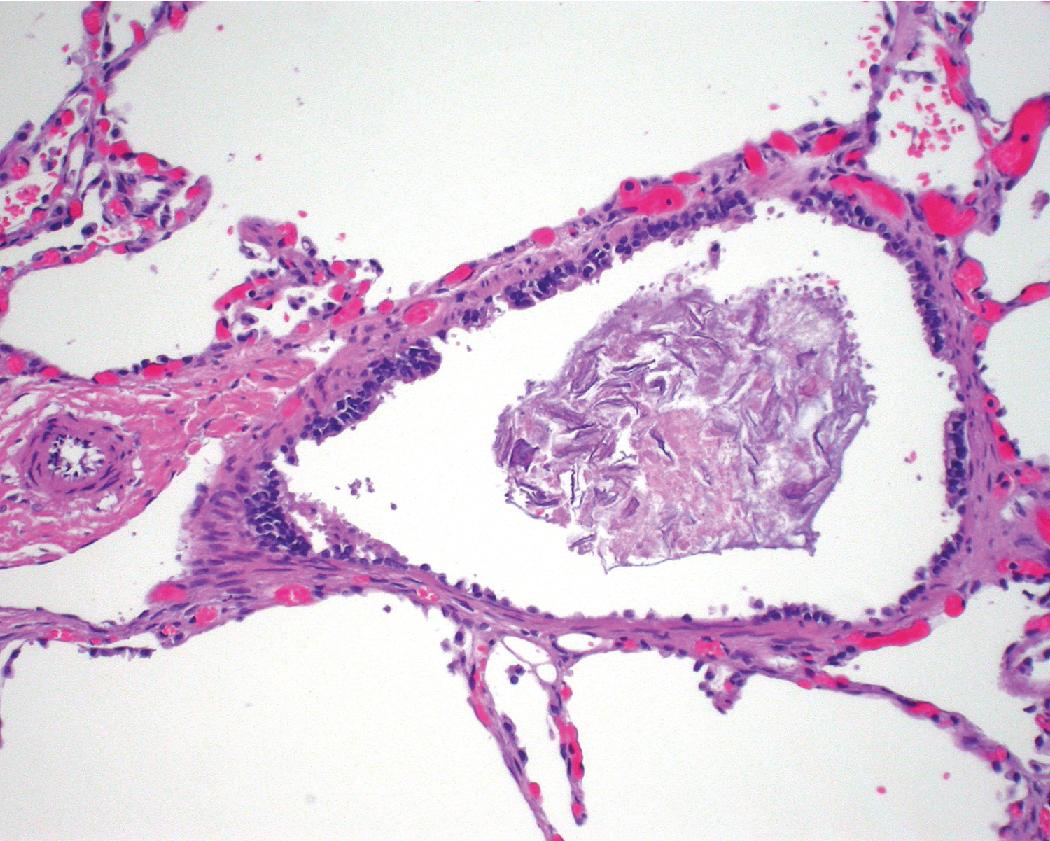
Polyalveolar lobe is a form of pulmonary hyperplasia which occurs when there is an increase in the regional number of alveoli relative to the corresponding conducting airways and arteries. Although the arteries and airways in these lungs are normal, the alveolar regions are enlarged by an increased number of nearly normal alveoli. The diagnosis can be made by radial alveolar counts, which are performed by counting the number of alveoli transected by a line drawn from the respiratory bronchiole to the nearest acinar edge (pleura or septum). The normal count varies with age but should be between 5 and 10 for infants, and 10 and 12 for young children. Radial alveolar counts in a polyalveolar lobe will be approximately 2 to 3 times that number ( Fig. 5.13 ).
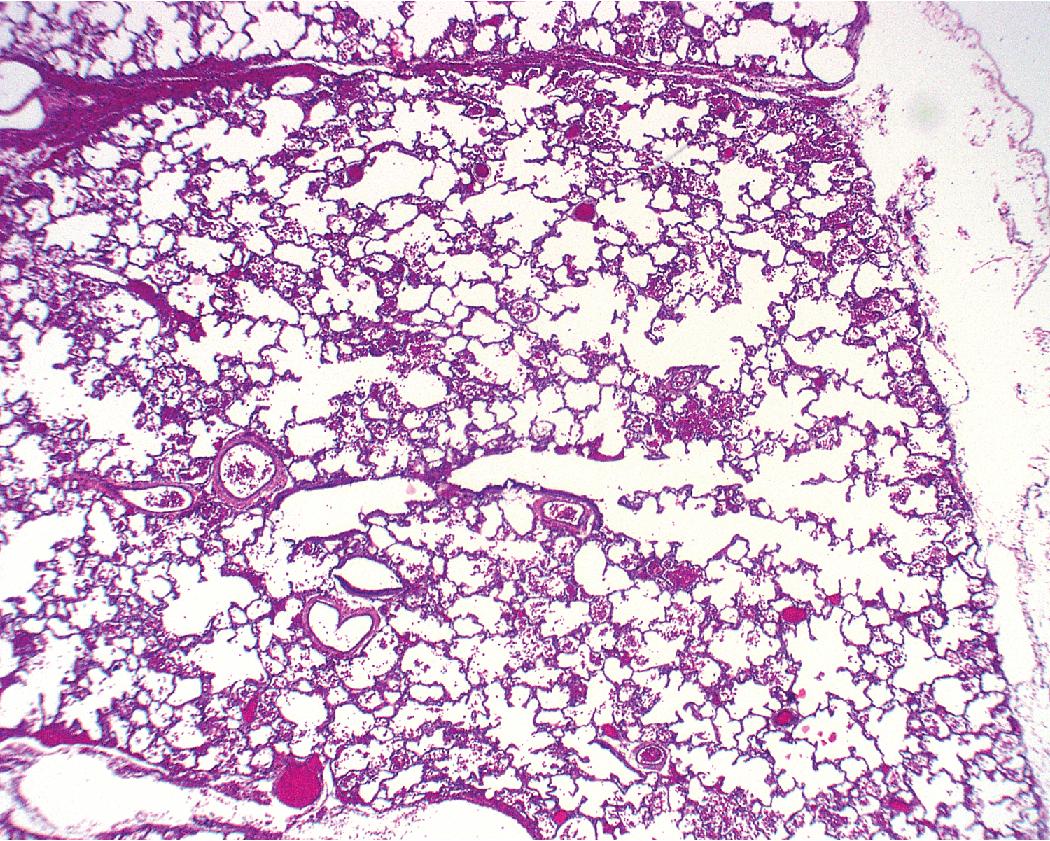
Become a Clinical Tree membership for Full access and enjoy Unlimited articles
If you are a member. Log in here